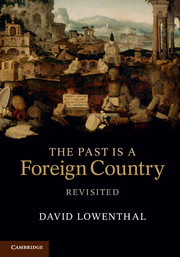Book contents
- Frontmatter
- Table of Contents
- List of illustrations
- List of permissions
- Acknowledgements
- List of abbreviations
- Introduction
- Part I Wanting the past
- Part II Disputing the past
- Part III Knowing the past
- Part IV Remaking the past
- 10 Saving the past: preservation and replication
- 11 Replacing the past: restoration and re-enactment
- 12 Improving the past
- Epilogue: the past in the present
- Select bibliography
- Index
- References
10 - Saving the past: preservation and replication
from Part IV - Remaking the past
Published online by Cambridge University Press: 05 November 2015
- Frontmatter
- Table of Contents
- List of illustrations
- List of permissions
- Acknowledgements
- List of abbreviations
- Introduction
- Part I Wanting the past
- Part II Disputing the past
- Part III Knowing the past
- Part IV Remaking the past
- 10 Saving the past: preservation and replication
- 11 Replacing the past: restoration and re-enactment
- 12 Improving the past
- Epilogue: the past in the present
- Select bibliography
- Index
- References
Summary
In a world of concrete and computers, it is vital that we preserve what remains of individuality. If everything were modern, everywhere would look pretty much the same.
Timothy Cantell, 1980A civilization which tends to conserve is a civilization in decline.
Pierre Boulez, 1975Blessed were the ancients, for they had no antiquities.
Italian sayingEfforts to save the past as it was, remaining true to its lineaments, take manifold forms. We safeguard material remnants and steward traditional skills and customs. We draw attention to the past with signposts and interpretive markers. We preserve and conserve. We replicate past forms and features in copies and reproductions. We bring back what has been lost, eroded, or corrupted in acts of restoration and resurrection. We seal the past in our hearts and minds by re-enacting and commemorating it.
These devotional endeavours aim to alter what remains as little as possible. The past is holy; changing it is impious, violating its integrity, improperly imposing present concerns. Actual practice mocks such piety: every mode of honouring the past to some extent transforms, even destroys. Yet the desire to keep sacrosanct and intact the pasts we have inherited, discovered, or contrived is potent and pervasive.
- Type
- Chapter
- Information
- The Past Is a Foreign Country – Revisited , pp. 413 - 463Publisher: Cambridge University PressPrint publication year: 2015

